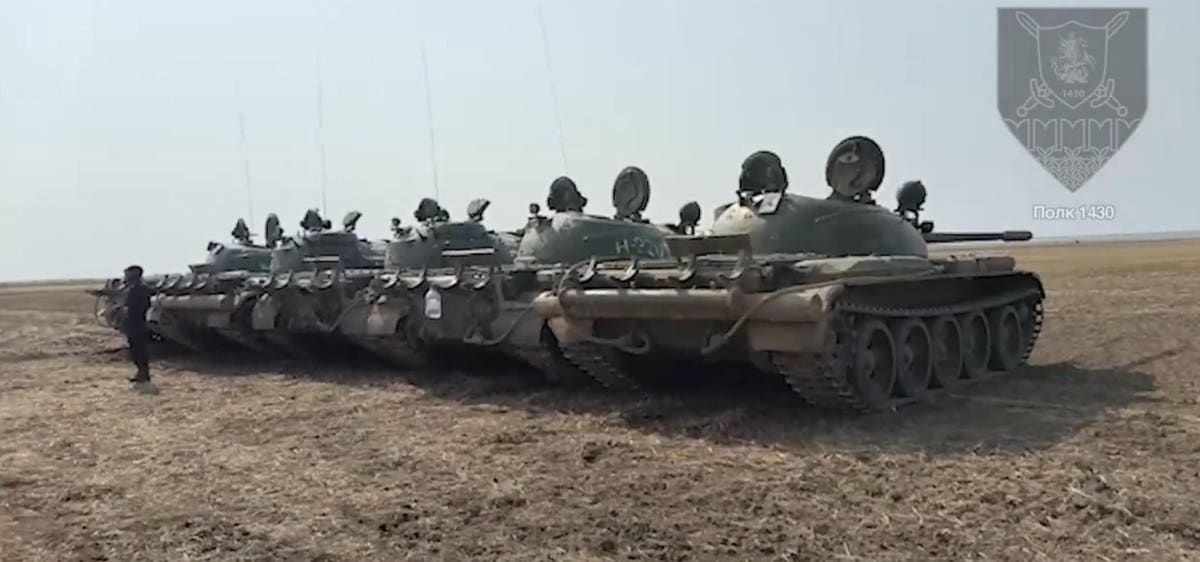In mid-August, as Ukrainian brigades began breaking through Russian lines in and around Robotyne—a key strongpoint along the axis leading all the way to Russian-occupied Melitopol, near the Black Sea coast—the Kremlin panicked.
It shifted, from the eastern front to the southern front, arguably the last elite division in Russia’s operational reserve: the 76th Guards Air Assault Division.
But the 76th GAAD’s potentially scores of modern T-72 and T-90 tanks aren’t the only Russian reinforcements converging on the Robotyne-Melitopol axis; the Russians apparently also are sending some very old T-55 tanks.
We know this because the unit operating the T-55s, the 1430th Motorized Rifle Regiment, proudly showed off the 1950s-vintage tanks in a video on its official Telegram channel on or just before Sunday.
The video depicts the 1430th MRR’s conscripts with early-model T-55s sporting L-2G infrared spotlights atop their D-10T 100-millimeter main guns.
The spotlight, and any target it illuminates, is visible in the T-55 gunner’s active infrared sight out to a distance of several hundred yards. The problem is, the spotlight also is visible to any enemy forces with infrared optics.
A T-55 can’t fight at night without giving itself away. By contrast, every tank in the Ukrainian inventory—even the Ukrainians’ super-upgraded ex-Slovenian T-55—has passive image-intensification or infrared sights that don’t require a spotlight. All Ukrainian tanks can fight at night without giving themselves away.
Of course, the 1430th MRR’s T-55s may never meet Ukrainian tanks in direct battle—at least not on purpose. The Russians generally aren’t deploying their 60-year-old T-62s, and especially their 70-year-old T-54s and T-55s, for armored assaults as part of combined-arms formations.
Instead, they’re positioning the tanks—sometimes with just a single person aboard—a few miles behind the line of contact and using them as crude howitzers. All Russian tanks have aiming reticles that allow for long-range ballistic shooting; Russian doctrine instructs tankers to functions as artillery gunners when the situation demands it.
It’s an expedient. “They make for an inefficient form of artillery,” Jack Watling and Nick Reynolds wrote about the aged tank-howitzers in a recent study for the Royal United Services Institute in London.
“Nevertheless, these engagements can often be made from positions that would not be viable for artillery, because of the tanks’ greater protection and thus reduced vulnerability to counterbattery fire,” Watling and Reynolds added.
And to be clear: Ukrainian counterbattery fire is a huge problem for Russian artillery on the southern front of Kyiv’s three-month-old counteroffensive.
In the artillery-on-artillery battle that has raged since Russia widened its war on Ukraine in February 2022, and which has intensified since the counteroffensive kicked off in June, Ukrainian guns lately have been knocking out three Russian guns for every one Ukrainian gun the Russians knock out.
Yes, it’s true Russian forces still have more tanks and artillery than Ukrainian forces do; yes, it’s true the Russian air force still flies more sorties than the Ukrainian air force does; yes, the Russians can fling more first-person-view drones at the Ukrainians than the Ukrainians can fling back.
But it’s not for no reason that the Kremlin is deploying its worst tanks to its most vulnerable sector. The Russians are under growing pressure as the Ukrainians’ momentum builds—especially south of Robotyne. So much pressure that the arrival of a few 70-year-old tanks apparently is cause for relief among beleaguered troops.
Read the full article here





